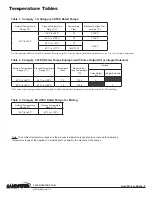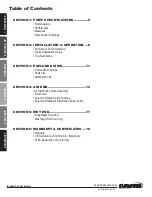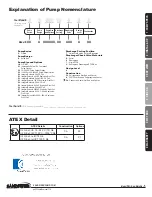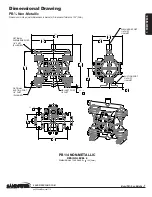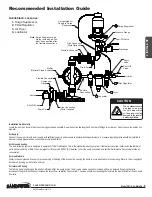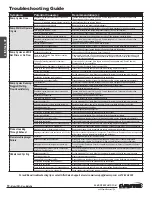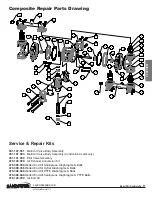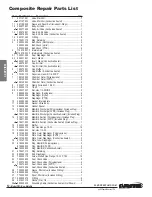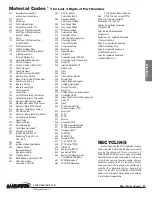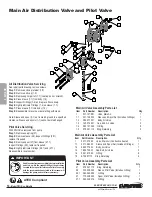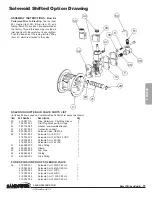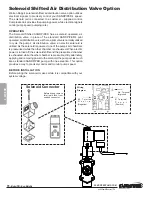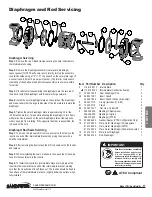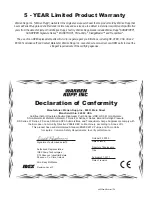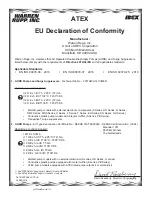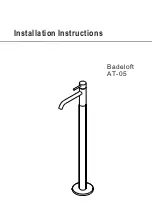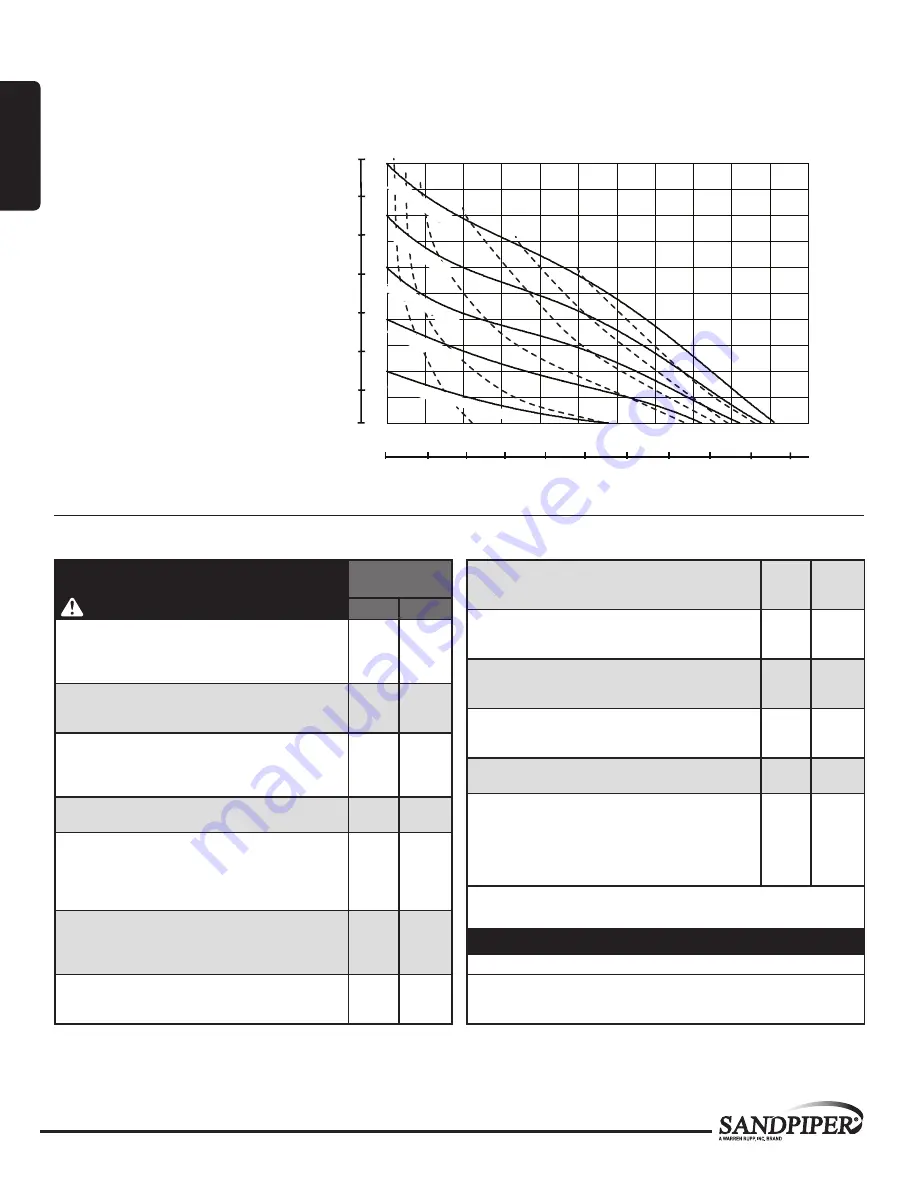
pb025nmdl4sm-rev1119
sandpiperpump
.
com
6
• Model PB¼ Non-Metallic
Performance
Materials
PB
¼
NON-METALLIC
SUCTION/DISCHARGE PORT SIZE
• ¼" NPT (internal)
• ½" NPT (external)
CAPACITY
• 0 to 5 gallons per minute
(0 to 19 liters per minute)
AIR DISTRIBUTION VALVE
• No-lube, no-stall design
SOLIDS-HANDLING
• Up to 0.032 in. (1mm)
HEADS UP TO
• 100 psi or 231 ft. of water
(7 bar or 70 meters)
DISPLACEMENT/STROKE
• .01 Gallon / .04 liter
SHIPPING WEIGHT
• Polypropylene 3.3 lbs. (1.5kg)
• PVDF 3.9 lbs. (1.8kg)
• Conductive Acetal 3.9 lbs. (1.8kg)
Material Profile:
Operating
Temperatures:
Max.
Min.
Conductive Acetal:
Tough, impact resistant, ductile. Good
abrasion resistance and low friction surface. Generally inert, with
good chemical resistance except for strong acids and oxidizing
agents.
190
°
F
88
°
C
-20
°
F
-29
°
C
EPDM:
Shows very good water and chemical resistance. Has
poor resistance to oils and solvents, but is fair in ketones and
alcohols.
280
°
F
138
°
C
-40
°
F
-40
°
C
FKM:
(Fluorocarbon) Shows good resistance to a wide range
of oils and sovents; especially all aliphatic, aromatic and
halogenated hydrocarbons, acids, animal and vegetable oils.
Hot water or hot aqueous solutions (over 70
°
F) will attack FKM.
350
°
F
177
°
C
-40
°
F
-40
°
C
Hytrel®:
Good on acids, bases, amines and glycols at room
temperatures only.
220
°
F
104
°
C
-20
°
F
-29
°
C
Neoprene:
All purpose. Resistance to vegetable oils. Generally
not affected by moderate chemicals, fats, greases and many
oils and solvents. Generally attacked by strong oxidizing acids,
ketones, esters and nitro hydrocarbons and chlorinated aromatic
hydrocarbons.
200
°
F
93
°
C
-10
°
F
-23
°
C
Nitrile:
General purpose, oil-resistant. Shows good solvent, oil,
water and hydraulic fluid resistance. Should not be used with
highly polar solvents like acetone and MEK, ozone, chlorinated
hydrocarbons and nitro hydrocarbons.
190
°
F
88
°
C
-10
°
F
-23
°
C
Nylon:
6/6 High strength and toughness over a wide
temperature range. Moderate to good resistance to fuels, oils
and chemicals.
180
°
F
82
°
C
32
°
F
0
°
C
Polypropylene:
A thermoplastic polymer. Moderate tensile
and flex strength. Resists stong acids and alkali. Attacked by
chlorine, fuming nitric acid and other strong oxidizing agents.
180
°
F
82
°
C
32
°
F
0
°
C
PVDF:
(Polyvinylidene Fluoride) A durable fluoroplastic with
excellent chemical resistance. Excellent for UV applications.
High tensile strength and impact resistance.
250
°
F
121
°
C
0
°
F
-18
°
C
Santoprene®:
Injection molded thermoplastic elastomer with
no fabric layer. Long mechanical flex life. Excellent abrasion
resistance.
275
°
F
135
°
C
-40
°
F
-40
°
C
UHMW PE:
A thermoplastic that is highly resistant to a broad
range of chemicals. Exhibits outstanding abrasion and impact
resistance, along with environmental stress-cracking resistance.
180
°
F
82
°
C
-35
°
F
-37
°
C
Urethane:
Shows good resistance to abrasives. Has poor
resistance to most solvents and oils.
150
°
F
66
°
C
32
°
F
0
°
C
Virgin PTFE:
(PFA/TFE) Chemically inert, virtually impervious.
Very few chemicals are known to chemically react with PTFE;
molten alkali metals, turbulent liquid or gaseous fluorine and
a few fluoro-chemicals such as chlorine trifluoride or oxygen
difluoride which readily liberate free fluorine at elevated
temperatures.
220
°
F
104
°
C
-35
°
F
-37
°
C
Maximum and Minimum Temperatures are the limits for which these materials can be operated.
Temperatures coupled with pressure affect the longevity of diaphragm pump components.
Maximum life should not be expected at the extreme limits of the temperature ranges.
Metals:
Alloy C:
Equal to ASTM494 CW-12M-1 specification for nickel and nickel alloy.
Stainless Steel:
Equal to or exceeding ASTM specification A743 CF-8M for corrosion
resistant iron chromium, iron chromium nickel and nickel based alloy castings for
general applicaitons. Commonly referred to as 316 Stainless Steel in the pump industry.
For specific applications, always consult the Chemical Resistance Chart.
CAUTION!
Operating temperature limitations are as follows:
MODEL
PB¼-A
Performance Curve
Performance based on the following: elastomer fitted pump, flooded suction, water at ambient conditions.
The use of other materials and varying hydraulic conditions may result in deviations in excess of 5%.
0
10
20
30
40
50
60
70
80
90
100
0
0.5
1
1.5
2
2.5
3
3.5
4
4.5
5
5.5
2 (3.4)
3 (5.1)
4 (6.8)
5 (8.5)
6 (10.2)
1
2
3
4
5
6
2
4
6
8
10
12
14
16
18
20
CAPACITY
HEAD
BAR
PSI
Liters per minute
U.S. Gallons per minute
1
7
0
1 (1.7)
100 PSI (6.8 Bar)
80 PSI (5.44 Bar)
60 PSI (4.08 Bar)
20 PSI (1.36 Bar)
40 PSI (2.72 Bar)
1: PUMP
SPECS



